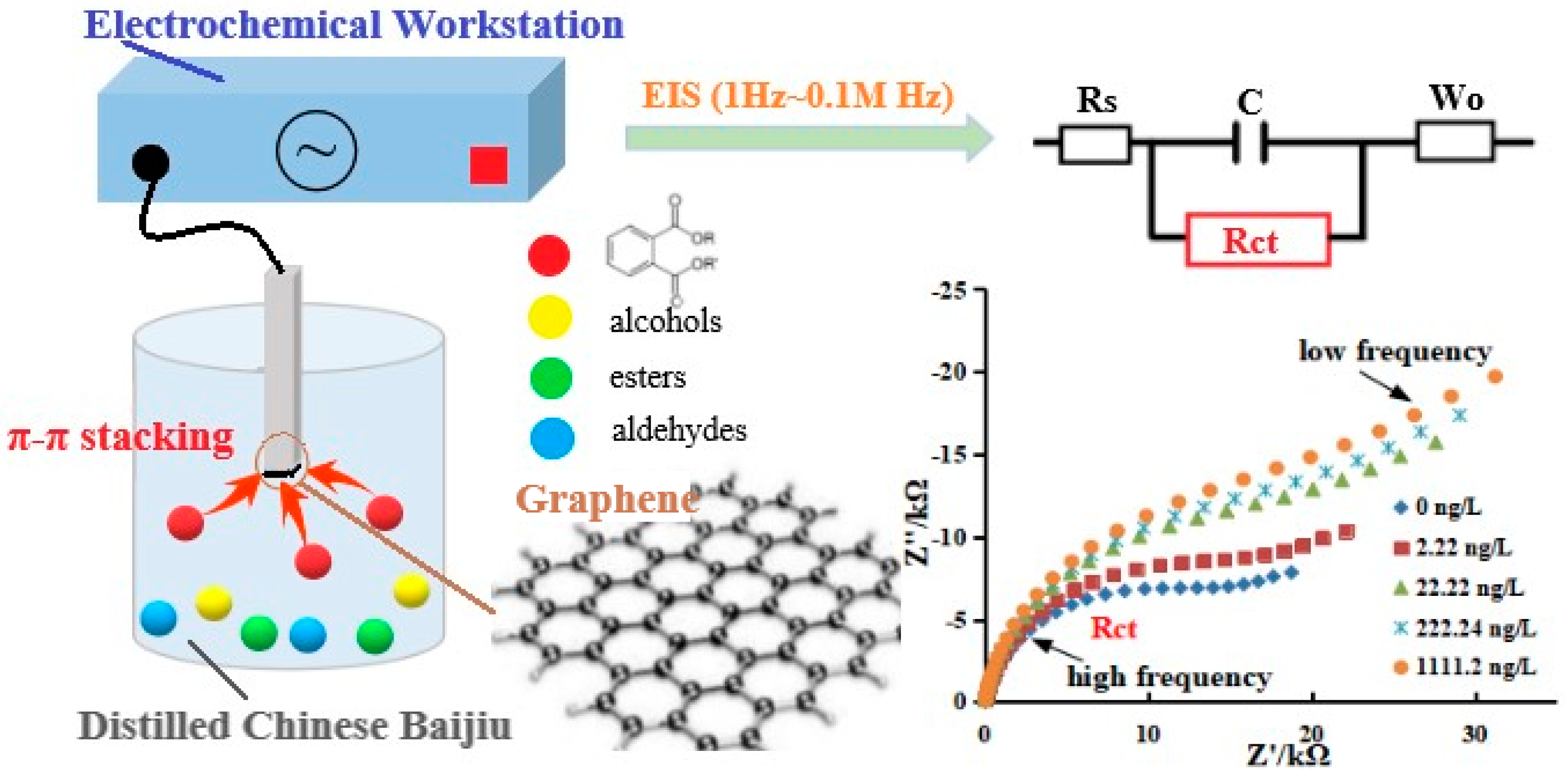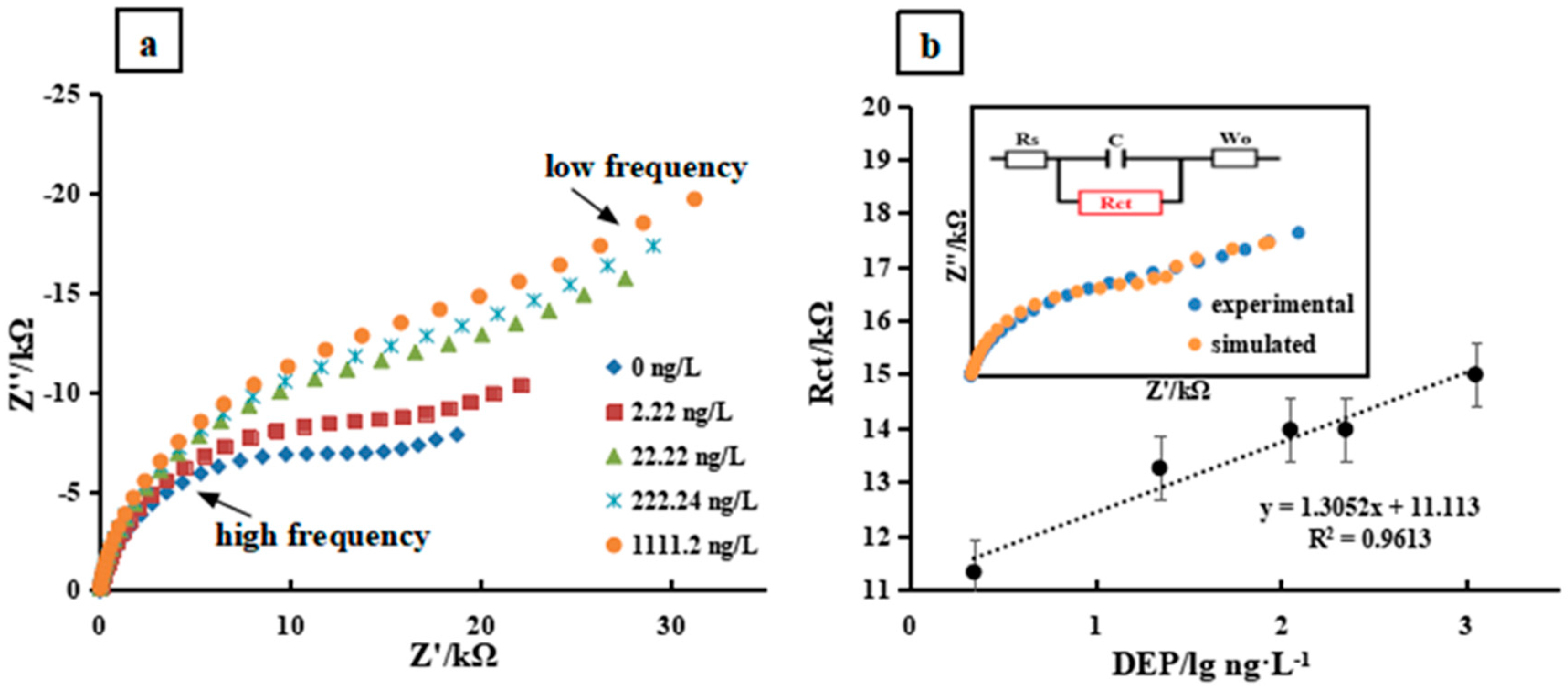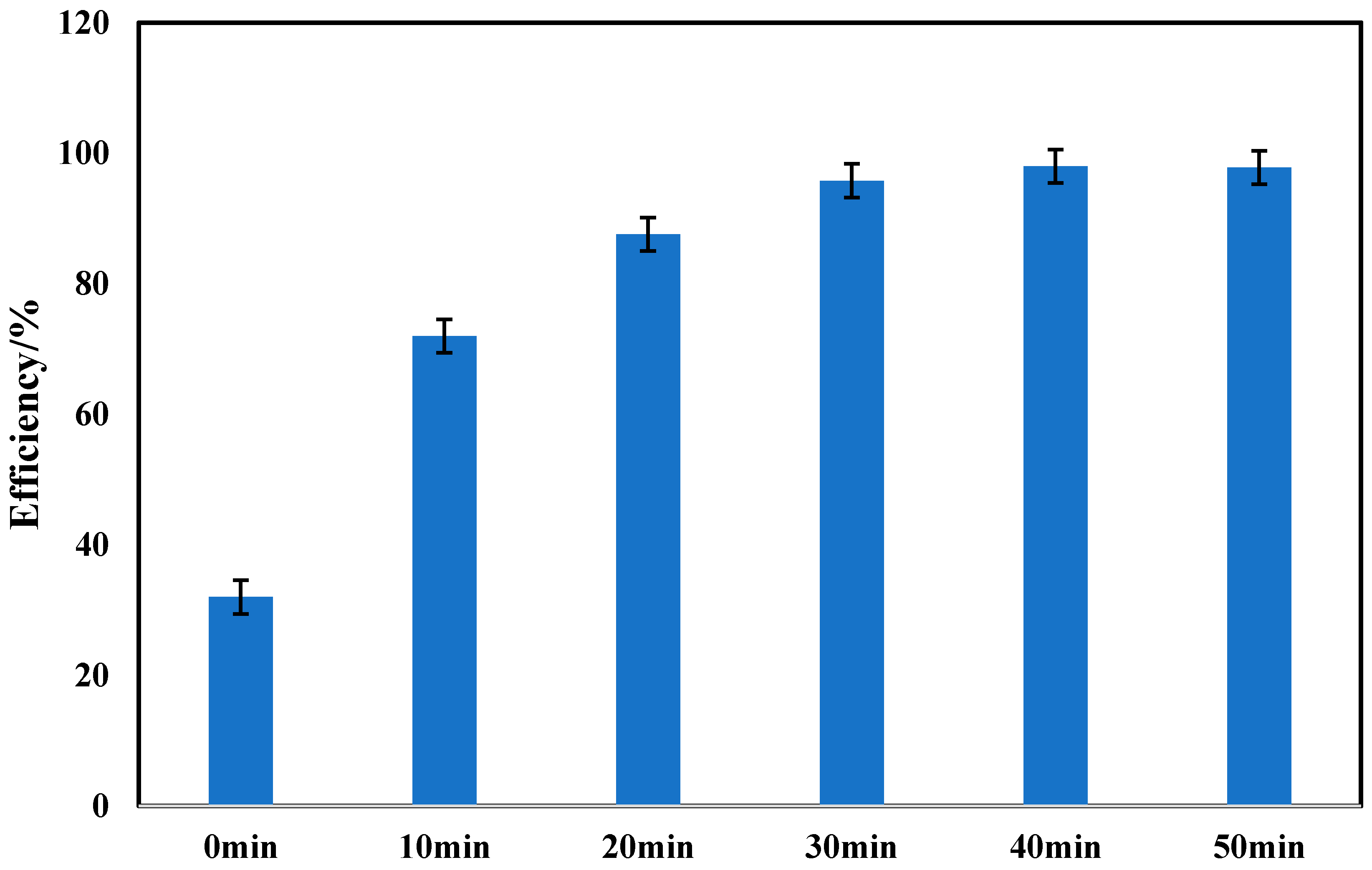Enrichment-Free Rapid Detection of Phthalates in Chinese Liquor with Electrochemical Impedance Spectroscopy
Abstract
:1. Introduction
2. Materials and Methods
2.1. Chemicals and Materials
2.2. Apparatus and Software
2.3. Preparation of Graphene Electrode
2.4. Electrochemical Measurements
2.5. Standard Solutions Preparation
2.6. Interference Elimination
2.7. Standard Addition
2.8. Method Validation with GC/MS
2.9. Quality Control and Quality Assurance
3. Results
3.1. Advantages of Graphene Electrode
3.2. Standard Curve
3.3. Elimination of Metal Ions Interference in the Chinese Liquor Sample
3.4. PAEs Quantification in Chinese Liquor
4. Conclusions
Author Contributions
Funding
Conflicts of Interest
References
- Gong, Y. Application and Hazard of Phthalic Acid Ester Plasticizer. Shandong Chem. Ind. 2011, 40, 93–95. [Google Scholar]
- Liu, F. Application of Plastcizer and Its Harm. Guangdong Chem. Ind. 2011, 38, 77. [Google Scholar]
- Liu, M. Analysis of Damage and Prevention of Plasticizer. J. Green Sci. Technol. 2013, 4, 210–212. [Google Scholar]
- Wang, M.S. Toxicity of Phthalate (PEAs) and Its Harm to Human Health. Jiangsu Prev. Med. 2011, 22, 68–70. [Google Scholar]
- Zhan, W.C. Food Safety Metaphor for Plasticizer Storm. Assets Financ. Adm. Inst. 2011, 11, 11–12. [Google Scholar]
- Zhang, T.K. From Clouding Agents to Plasticizers. Sci. Technol. Vis. 2011, 7, 66–67. [Google Scholar]
- Salazar-Beltrán, D.; Hinojosa-Reyes, L.; Ruiz-Ruiz, E. Phthalates in Beverages and Plastic Bottles: Sample Preparation and Determination. Food Anal. Methods 2018, 3, 1–14. [Google Scholar] [CrossRef]
- Khosravi, K.; Price, G.W. Determination of phthalates in soils and biosolids using accelerated solvent extraction coupled with SPE cleanup and GC-MS quantification. Microchem. J. 2015, 121, 205–212. [Google Scholar] [CrossRef]
- Duty, S.M.; Calafat, A.M.; Silva, M.J. The relationship between environmental exposure to phthalates and computer-aided sperm analysis motion parameters. J. Androl. 2004, 25, 293–302. [Google Scholar] [CrossRef]
- Rahman, M.; Brazel, C.S. The plasticizer market: An assessment of traditional plasticizers and research trends to meet new challenges. Prog. Polym. Sci. 2004, 29, 1223–1248. [Google Scholar] [CrossRef]
- Sioen, I.; Fierens, T.; Van, H.M. Phthalates dietary exposure and food sources for Belgian preschool children and adults. Environ. Int. 2012, 48, 102–108. [Google Scholar] [CrossRef] [PubMed]
- Sun, X.; Zong, W.; Liu, C. Investigation on the toxic interaction of typical plasticizers with calf thymus DNA. J. Lumin. 2015, 161, 71–75. [Google Scholar] [CrossRef]
- Castle, L. Gas chromatographic-mass spectrometric determination of adipate-based polymeric plasticizers in foods. J. Assoc. Off. Anal. Chem. 1988, 71, 394. [Google Scholar] [PubMed]
- Fung, Y.S.; Tang, A.S.K. Liquid chromatographic determination of the plasticizer di (2-ethylhexyl) phthalate (DEHP) in PVC plastics. Fresen. J. Anal. Chem. 1994, 350, 721–723. [Google Scholar] [CrossRef]
- Wang, Y.; Shi, X.; Wu, Z. Rapid Detection of Phthalate by NIR Spectroscopy. Chin. J. Exp. Trad. Med. Formulae 2013, 19, 86–90. [Google Scholar]
- Zhang, M.; Wang, Y.; Yu, X. Rapid monitoring of dicyclohexyl phthalate in foods using the direct competitive ELISA. Food Agr. Immunol. 2014, 25, 229–242. [Google Scholar] [CrossRef]
- Zhuang, H.; Liu, S.; Zhang, M. Determination of Dimethyl Phthalate in Environment Water Samples by a Highly Sensitive Indirect Competitive ELISA. Appl. Biochem. Biotechnol. 2012, 166, 436–445. [Google Scholar] [CrossRef]
- Li, X.; Wang, X.; Li, L. Electrochemical sensor based on magnetic graphene oxide@gold nanoparticles-molecular imprinted polymers for determination of dibutyl phthalate. Talanta 2015, 131, 354–360. [Google Scholar] [CrossRef]
- Turco, V.L.; Di Bella, G.; Potortì, A.G.; Fede, M.R.; Dugo, G. Determination of plasticizer residues in tea by solid phase extraction-gas chromatography-mass spectrometry. Eur. Food Res. Technol. 2015, 240, 451–458. [Google Scholar] [CrossRef]
- Zhao, J.; Zhang, S. Study on the change rule of metal element content in liquor storage. J. Sichuan Univ. Sci. Eng. 2008, 21, 65–67. [Google Scholar]
- Wang, Y.; Fang, Y. Analysis of Plasticiers in glucose by Thin Layer Chromatography. J. Mod. Sci. Instrum. 2006, 1, 102–104. [Google Scholar]
- Li, M.; Wu, J.; Zeng, W. Determination of phthalates in water by liquid phase microextraction and gas chromatography. Chin. J. Analy. Chem. 2006, 34, 127–129. [Google Scholar]
- Wang, S.; Lei, W.; Du, X. Determination of phthalate Ester Residues in Liquor by Gas Chromatography Tandem Triple Quadruple Mass Spectrometry (GC-MS/MS) with Iotopic Internal Standards. Chem. Reag. 2015, 37, 443–446. [Google Scholar]
- Fernández-Amado, M.; Prieto-Blanco, M.C.; López-Mahía, P. A comparative study of extractant and chromatographic phases for the rapid and sensitive determination of six phthalates in rainwater samples. Chemosphere 2017, 175, 52–65. [Google Scholar] [CrossRef]
- Zhao, X.; Ju, X.; Qiu, S. Fast and Sensitive Detection of Diisononyl Phthalate in Liquor Sample by Molecularly Imprinted Polymer Based Electrochemical Sensor. Russ. J. Electrochem. 2018, 54, 636–643. [Google Scholar] [CrossRef]
- Santana-Mayor, A.; Socas-Rodríguez, B.; Mdm, A. Reduced graphene oxide-coated magnetic-nanoparticles as sorbent for the determination of phthalates in environmental samples by micro-dispersive solid-phase extraction followed by ultra-high-performance liquid chromatography tandem mass spectrometry. J. Chromatogr. A 2018, 1565, 36. [Google Scholar] [CrossRef]
- González-Sálamo, J.; Hernández-Borges, J.; Mdm, A. Determination of phthalates in beverages using multiwalled carbon nanotubes dispersive solid-phase extraction before HPLC-MS. J. Sep. Sci. 2018, 41, 2613–2622. [Google Scholar] [CrossRef]
- Hou, Z.; Zhou, Y.; Li, G. Preparation and Properties of Graphene Thin Films. J. Shenyang Univ. 2015, 27, 16. [Google Scholar]
- Khan, U.; May, P.; O’Neill, A. Development of stiff, strong, yet tough composites by the addition of solvent exfoliated graphene to polyurethane. Carbon 2010, 48, 4035–4041. [Google Scholar] [CrossRef]
- Sinnokrot, M.O.; Sherrill, D.C. High-accuracy quantum mechanical studies of pi-pi interactions in benzene dimers. J. Phys. Chem. A 2006, 110, 10656–10668. [Google Scholar] [CrossRef]
- Tsuzuki, S.; Honda, K.; Uchimaru, T. Origin of attraction and directionality of the pi/pi interaction: Model chemistry calculations of benzene dimer interaction. J. Am. Chem. Soc. 2002, 124, 104–112. [Google Scholar] [CrossRef] [PubMed]
- Liu, T.; Li, Y.; Du, Q. Adsorption of methylene blue from aqueous solution by graphene. Colloids Surf. B 2012, 90, 197–203. [Google Scholar] [CrossRef] [PubMed]
- Ramesha, G.K.; Kumara, A.V.; Muralidhara, H.B. Graphene and graphene oxide as effective adsorbents toward anionic and cationic dyes. J. Colloid Interface Sci. 2011, 361, 270–277. [Google Scholar] [CrossRef] [PubMed]
- Wu, C.C.; Ku, B.C.; Ko, C.H. Electrochemical impedance spectroscopy analysis of A-beta (1-42) peptide using a nanostructured biochip. Electrochim. Acta. 2014, 134, 249–257. [Google Scholar] [CrossRef]
- Liu, H.; Sun, B. Effect of Fermentation Processing on the Flavor of liquor. J. Agric. Food Chem. 2018, 66, 5425. [Google Scholar] [CrossRef]
- Zhang, M.; He, L. Research progress of methanol, formaldehyde, cyanide and metal ions in Chinese liquor. J. Food Saf. Qual. 2015, 9, 3563–3568. [Google Scholar]




| Analytical Technique | Matrix | Compounds | LOD ng/L | Sample Pretreatment | Reference |
|---|---|---|---|---|---|
| TLC | Glucose | DEP | 2.4 | Multi-step | [20] |
| Fluorescence | Waste water | DEP | 18,440 | None | [21] |
| GC | Water | DEP | 3.7 | Liquid phase extraction | [22] |
| (GC-MS/MS) | Chinese liquor | DEP | 100 | Liquid phase extraction | [23] |
| GC-MS | Alcoholic beverages | DEP | 700,000 | Centrifugation extraction | [7] |
| LC-DAD | Red wine | DEP | 2000 | Separation and elution | [7] |
| HPLC | Rainwater | DEP | 200 | In-tube SPME | [24] |
| Electrochemical Sensor | Chinese liquor | DINP | 11,300 | None | [25] |
| UHPLC-MS | Waste water | DBEP | 6 | SPEM | [26] |
| HPLC-MS | Beverage | 9 PAEs | 173 | SPE | [27] |
| Sample | EIS | GC/MS | Error (mg/L) | ||
|---|---|---|---|---|---|
| DEP (mg/L) | Standard Deviation (N = 3) | DEP (mg/L) | Standard Deviation (N = 3) | ||
| Xiaoqu liquor | 0.149 | 0.021 | 0.135 | 0.012 | +0.014 |
| Daqu liquor | 0.170 | 0.018 | 0.191 | 0.025 | −0.021 |
| Medicinal liquor | 1.234 | 0.020 | 1.200 | 0.024 | +0.034 |
© 2020 by the authors. Licensee MDPI, Basel, Switzerland. This article is an open access article distributed under the terms and conditions of the Creative Commons Attribution (CC BY) license (http://creativecommons.org/licenses/by/4.0/).
Share and Cite
Jiang, X.; Xie, Y.; Wan, D.; Zheng, F.; Wang, J. Enrichment-Free Rapid Detection of Phthalates in Chinese Liquor with Electrochemical Impedance Spectroscopy. Sensors 2020, 20, 901. https://doi.org/10.3390/s20030901
Jiang X, Xie Y, Wan D, Zheng F, Wang J. Enrichment-Free Rapid Detection of Phthalates in Chinese Liquor with Electrochemical Impedance Spectroscopy. Sensors. 2020; 20(3):901. https://doi.org/10.3390/s20030901
Chicago/Turabian StyleJiang, Xinyue, Yuqun Xie, Duanji Wan, Fuping Zheng, and Jun Wang. 2020. "Enrichment-Free Rapid Detection of Phthalates in Chinese Liquor with Electrochemical Impedance Spectroscopy" Sensors 20, no. 3: 901. https://doi.org/10.3390/s20030901
APA StyleJiang, X., Xie, Y., Wan, D., Zheng, F., & Wang, J. (2020). Enrichment-Free Rapid Detection of Phthalates in Chinese Liquor with Electrochemical Impedance Spectroscopy. Sensors, 20(3), 901. https://doi.org/10.3390/s20030901




